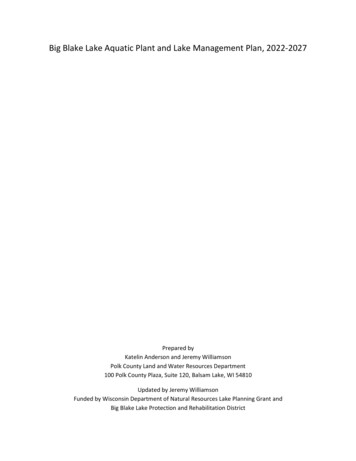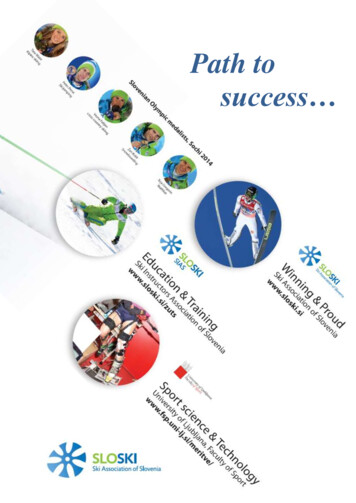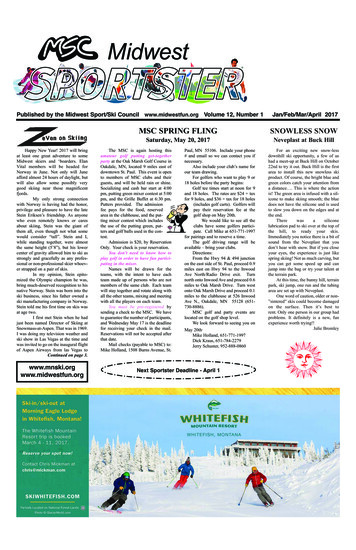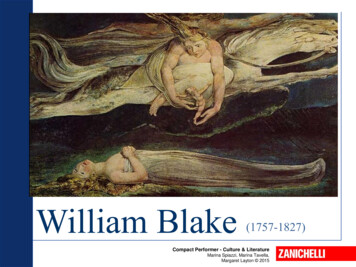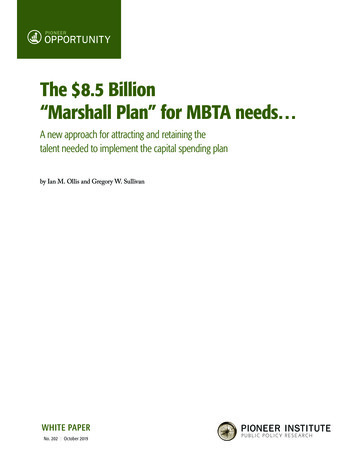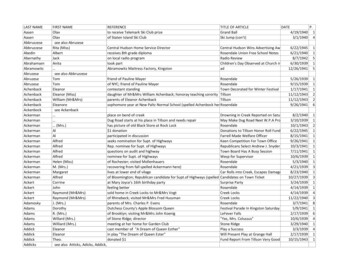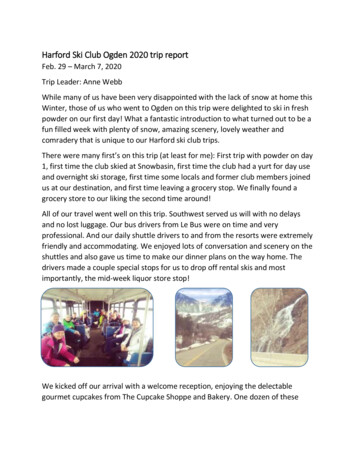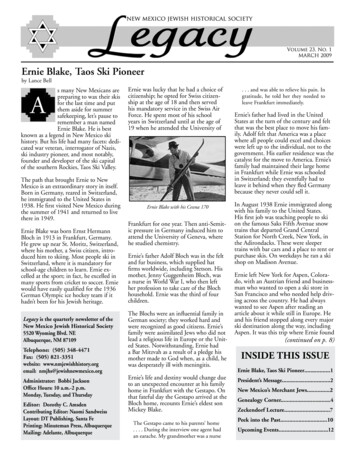
Transcription
Ernie Blake, Taos Ski Pioneerby Lance Bells many New Mexicans arepreparing to wax their skisfor the last time and putthem aside for summersafekeeping, let’s pause toremember a man namedErnie Blake. He is bestknown as a legend in New Mexico skihistory. But his life had many facets: dedicated war veteran, interrogator of Nazis,ski industry pioneer, and most notably,founder and developer of the ski capitalof the southern Rockies, Taos Ski Valley.AThe path that brought Ernie to NewMexico is an extraordinary story in itself.Born in Germany, reared in Switzerland,he immigrated to the United States in1938. He first visited New Mexico duringthe summer of 1941 and returned to livethere in 1949.Ernie Blake was born Ernst HermannBloch in 1913 in Frankfurt, Germany.He grew up near St. Moritz, Switzerland,where his mother, a Swiss citizen, introduced him to skiing. Most people ski inSwitzerland, where it is mandatory forschool-age children to learn. Ernie excelled at the sport; in fact, he excelled inmany sports from cricket to soccer. Erniewould have easily qualified for the 1936German Olympic ice hockey team if ithadn’t been for his Jewish heritage.Legacy is the quarterly newsletter of theNew Mexico Jewish Historical Society5520 Wyoming Blvd. NEAlbuquerque, NM 87109Telephone: (505) 348-4471Fax: (505) 821-3351website: www.nmjewishhistory.orgemail: nmjhs@jewishnewmexico.orgAdministrator: Bobbi JacksonOffice Hours: 10 a.m.-2 p.m.Monday, Tuesday, and ThursdayEditor: Dorothy C. AmsdenContributing Editor: Naomi SandweissLayout: DT Publishing, Santa FePrinting: Minuteman Press, AlbuquerqueMailing: Adelante, AlbuquerqueErnie was lucky that he had a choice ofcitizenship; he opted for Swiss citizenship at the age of 18 and then servedhis mandatory service in the Swiss AirForce. He spent most of his schoolyears in Switzerland until at the age of19 when he attended the University ofErnie Blake with his Cessna 170Frankfurt for one year. Then anti-Semitic pressure in Germany induced him toattend the University of Geneva, wherehe studied chemistry.Ernie’s father Adolf Bloch was in the feltand fur business, which supplied hatfirms worldwide, including Stetson. Hismother, Jenny Guggenheim Bloch, wasa nurse in World War I, who then lefther profession to take care of the Blochhousehold. Ernie was the third of fourchildren.The Blochs were an influential family inGerman society; they worked hard andwere recognized as good citizens. Ernie’sfamily were assimilated Jews who did notlead a religious life in Europe or the United States. Notwithstanding, Ernie hada Bar Mitzvah as a result of a pledge hismother made to God when, as a child, hewas desperately ill with meningitis.Ernie’s life and destiny would change dueto an unexpected encounter at his familyhome in Frankfurt with the Gestapo. Onthat fateful day the Gestapo arrived at theBloch home, recounts Ernie’s eldest sonMickey Blake.The Gestapo came to his parents’ home. . . . During the interview one agent hadan earache. My grandmother was a nurse. . . and was able to relieve his pain. Ingratitude, he told her they needed toleave Frankfurt immediately.Ernie’s father had lived in the UnitedStates at the turn of the century and feltthat was the best place to move his family. Adolf felt that America was a placewhere all people could excel and choiceswere left up to the individual, not to thegovernment. His earlier residence was thecatalyst for the move to America. Ernie’sfamily had maintained their large homein Frankfurt while Ernie was schooledin Switzerland; they eventfully had toleave it behind when they fled Germanybecause they never could sell it.In August 1938 Ernie immigrated alongwith his family to the United States.His first job was teaching people to skion the famous Saks Fifth Avenue snowtrains that departed Grand CentralStation for North Creek, New York, inthe Adirondacks. These were sleepertrains with bar cars and a place to rent orpurchase skis. On weekdays he ran a skishop on Madison Avenue.Ernie left New York for Aspen, Colorado, with an Austrian friend and businessman who wanted to open a ski store inSan Francisco and who needed help driving across the country. He had alwayswanted to see Aspen after reading anarticle about it while still in Europe. Heand his friend stopped along every majorski destination along the way, includingAspen. It was this trip where Ernie found(continued on p. 8)INSIDE THIS ISSUEErnie Blake, Taos Ski Pioneer.1President’s Message.2New Mexico’s Merchant Jews.2Genealogy Corner.4Zeckendorf Lecture.7Peek into the Past.10Upcoming Events.12
Legacy, Volume 23, Number 1, March 2009Message from President Noel Pugachaving taught history atthe university level forover forty years, I amalways pleased whenformer students stop meand confess that theyhated history in highschool and college. But now that theyhave grown older and have experiencedlife, they appreciate the importance ofthe subject and remember my injunctions to think historically. Indeed, somego further and express their delight inreading history or watching the HistoryChannel. Perhaps history is “wasted onthe young.”HI am also thrilled when members of theNew Mexico Jewish Historical Societyand guests at our programs tell me howmuch they enjoy learning about NewMexico Jewish history. They were unaware of the many aspects of the Jewishpresence in our state and region and findthe discovery fascinating and rewarding. That, of course, is our mission: tomine, expose, and disseminate theseriches through means of public lectures,conferences, workshops, and this finenewsletter, Legacy.That point was clearly made by thecapacity audience that heard BettinaO’Neil Lyons trace the history of herancestors, the Steinfelds and especiallythe Zeckendorfs, in the Southwest onSunday, February 22. Former NMJHSpresident Harold Melnick has writtena fine account of the program in hisarticle in this issue.The Society has a number of important activities in the offing. Our annualcleanup of the Montefiore Cemetery inLas Vegas will be held on Sunday, April26. The annual meeting will take placeon May 17 in Santa Fe. Following ashort business meeting,Dr. Henry Tobias, whohas published two bookson Jews in New Mexico,will speak on his recentJews in New Mexico:Another Look, and signcopies.In our lead story, Lance Bell, anotherformer president of ourorganization, has provided an intriguing andinformative snapshot ofErnie Blake, who createdTaos Ski Valley. Blake’sother achievements arealso compelling. With anintroduction from Lance, IFinally, I urge you to behad the distinct pleasure ofmindful of the ways youinterviewing Mr. Samuelcan serve your Society. IfAdelo, who is a rich sourceyou know someone whoof information and inmight be interested insights on the relationshipjoining, contact our officebetween Lebanese andNMJHS President Noel Pugach.or one of the board memJewish merchants in Newbers. If you have a specialMexico. Some of that maoccasion to mark, consider putting aterial appears in an essay in this issue.notice in Legacy with a donation to theSociety. I am delighted to honor our deReaders will find other treasures invoted member Stanley Feinstein in suchthis issue, so well edited by Dorothya fashion on the occasion of his eightiAmsden. Don’t miss Naomi Sandweiss’s timely column on Jews and the eth birthday. If you have documentarymaterial, remember that NMJHS has aGreat Depression. Dorothy Amsdenspecial collection at the State Archivescontributes this quarter’s Genealogyand Record Center in Santa Fe.Corner. I am delighted to welcomeSteve Gitomer, who will take over theI look forward to seeing you at upcomreins of the Genealogy Committeefrom Dorothy. See his mini-bio in this ing events this year. See page 12 of thisissue for dates, times, and places. Aissue.New Mexico’s Merchant Jews: Another Perspectiveby Noel Pugachyoung boy accompanieshis storekeeper father toobserve how he transactsbusiness in Las Vegas,New Mexico, with theTerritory’s preeminentmerchant and wholesaler Charles Ilfeld.His father orders some goods, makes abrief effort at bargaining for a lower price,and then seals the matter with a handshake. Perhaps at this visit, the merchantprince pulls out a couple of boxes of cigarswith the Charles Ilfeld label on them. Thetwo men inquire about each other’s healthand that of their families.AThroughout, the conversation betweenthe two is cordial and respectful. Beforereturning to their home in Pecos, thefather takes his son to a few other stores,Page 2perhaps those of Mr. Joseph Taichert orthe Rosenwald establishment. This wasthe father’s method of teaching his sonhow to talk to the wholesalers and suppliers, how businessmen dealt with one another. Perhaps the son would one day takeover the family store. The lessons wouldbe repeated many more times in Las Vegasand later Santa Fe.This young boy was eighty-five by thetime I met him last summer. My firstimpression of Mr. A. Samuel Adelo wasthat of a striking and charming individual,who looked and carried himself like amuch younger man. Still trim, handsome,distinguished-looking, and well-dressed,he is an articulate, alert, and sophisticatedgentleman. Although he later protestedthat his memory occasionally fails him,there is no question that his wits andintelligence are intact.As we met at one of his favorite restaurants just off the Plaza in Santa Fe, itbecame obvious that he was a frequentpatron and well known in the “City Different.” Lance Bell, a former NMJHSpresident and scion of a leading merchantfamily, arranged the meeting, suggestingthat I interview Sam about northern NewMexico merchant Jews. Sam could notonly provide first-hand information butalso a non-Jewish perspective.Over lunch, Sam, Lance, and I quicklyconnected and soon we were talkingabout Jews and Lebanese, commerce and(continued on p. 3)
New Mexico Jewish Historical SocietyNew Mexico’s Merchant Jews (continued from p. 2)culture, the New Mexico past and thepresent. After an hour, Sam and I left therestaurant and walked to the Fray Angelico Chavez Library to conduct a tapedinterview.Abdallah Samuel Adelo was born in Pecos,New Mexico, on February 16, 1923.His father, also known as Sam in theUnited States, was named in Arabic AssadBouhabib. He had migrated from a townnear Beirut, Lebanon (then part of Syria),in 1913, at the encouragement of a veryclose uncle, Charles Fidel, a Las Vegasmerchant. As was true for Jewish andother settlers, the Lebanese were drawn toNew Mexico by the promise of economicopportunity.These Maronite Catholics had been farmers and laborers in Syria, but almost allturned to trade when they migrated to theUnited States, Latin America, and evenAfrica. While many like Sam’s paternalgrandfather, who had a store west of Wagon Mound, New Mexico, returned to hisSyrian village, others decided to remainin the United States. Some of their sonsstayed in the family business, but manybecame successful in the professions andother forms of enterprise. Representativenames included Michael, Maloof, Koury,Sahd, Fidel, Hanosh, and Adelo.Although he started as an itinerant trader,Sam’s father Assad Bouhabib owned ageneral store in Pecos by the time Samwas born. In addition, unlike many of hispeers who went back to Lebanon (Syria)to find wives, Assad married LourdesBarela Silva, a native of Pecos. Like manyLebanese immigrants, Sam’s parentsimpressed the importance of educationon their children; Assad had studied atthe American University of Beirut andhad taught school before coming to theUnited States. For high school, Sam attended St. Michael’s College in Santa Feand then spent a year at a military school,St. Joseph’s Academy in Kansas.Sam came back to Pecos to help his fatherin his store, but he was not destined tobecome a storekeeper. Sam started at theUniversity of Notre Dame, but his studieswere interrupted by Army service duringWorld War II. After the war, Sam receivedhis B.A. from Notre Dame, an M.A. inSpanish from Northwestern University,and a law degree from Notre Dame.Except for a brief period as a translator forthe State Department, Sam Adelo workedfor a number of oil and natural resourcecompanies as an in-house attorney andpublic affairs spokesman.As a result of his work, Sam entered a longperiod of “exile” from New Mexico, livingin various countries and traveling extensively throughout the world. The Gulf OilCompany, which had major petroleumand uranium holdings in New Mexico, finally brought him back to his native statein 1976. When, Sam retired from Gulfafter a rich 30-year career in 1984, heknew he had to remain active. In additionto serving on various boards, he worksregularly as a certified Spanish translatorfor the courts in Santa Fe, where he liveswith his wife, the former Lueretta Evans.The Adelos, Sam informed me, had fondmemories of the Jewish merchants ofNew Mexico. They had helped Assad andmany of the other Lebanese merchants getstarted in business. When Assad first cameto Las Vegas, Charles Ilfeld supplied himwith a team of horses and a wagon full ofmerchandise on his word.After traveling to the small villages andranches, the Lebanese merchant earnedenough to pay for the merchandise andwas given another wagon load on credit.Before too long he was able to settledown in Pecos and open his own store,now known as Adelo’s Town & Country.(The store is currently managed by Sam’snephews.) Consequently, Assad BouhabibSam Adelo was always gratified to associate with Jews and regarded the Jewishmerchants as friends as well as suppliers.For the rest of his life, Assad, as did theother Lebanese store owners, continuedto deal with the Jewish merchants in LasVegas and later Santa Fe. After all, theJews were a vital part of the economic lifeof New Mexico. They were hard-working,fair, dependable and trustworthy; theywere respected and admired. While theLebanese did not know much about theirsocial life, they were considered modelsbecause they were good businessmenand they sent their sons and daughters toschool, many of them “becoming goodprofessionals.” Interestingly, the Lebanesemerchants were called “Arabes” by thelocal Hispanic population, but the sameterm was often applied to Jews.When I asked Sam if the old stereotypesof Jewish merchants—of being conniving, cheap, rapacious, tough bargainerswere common among the Lebanese, Samreplied that he never heard that kind oftalk. “We didn’t have any of . . . this ideasmashed in your brain . . . . We didn’tlook upon them as stereotypes.” Instead,the Lebanese regarded them as individuals. “That’s how we identified them, byname,” he added.Once Sam Adelo got resettled in NewMexico in 1976, he renewed his associations with the Jewish businessmen andmade new friendships. “The first place Ivisited was the Taichert store in Las Vegaswith my father,” he recalled. By thattime, however, there were few of the oldGerman Jewish merchants left; most ofthem had died and their enterprises disappeared. The Sterns (of Stern & Nahm)were still around, but for some reasonAssad never took him into their store.In adjacent Mora County, Sam did meetsome of the Regensbergs, who were stillprominent in the area. Jacob Regensberg was a pioneer Jewish merchant whoarrived in 1867, but nearly all of his descendants became Catholic. A newcomerto Mora, David Salman, was perhaps theonly Jew in the county. Salman had beena shipping magnate in Houston, but hadfallen in love with Mora County. Hebought the historic La Cueva Ranch andbreathed new life into it by raising andselling agricultural products, especially hisfamous raspberries.David Salman was also elected to the StateHouse of Representatives and became aleading member of the liberal wing of theDemocratic Party, known as the “MamaLucys” in the 1970s, until a terrible autoaccident forced him into retirement. SamAdelo developed a friendship with Salmanand engaged in long conversations withhim. Sam considered David Salman the“smartest” person in New Mexico.But it was in Santa Fe that Sam Adeloforged his closest personal ties with theJewish merchant community. When hewas a high school student, his father tookhim to the many Jewish-owned stores thatdominated the Plaza by the 1930s. In particular, he remembered their shopping atSpitz’s, the premier jewelry store in SantaFe. Whenever his father had to buy jewelry or watches, his father “always thoughtof Spitz, like ‘where else,’” Sam remarked.“And the prices were fair. And if something went wrong, he could go back andget it fixed.” Sam ticked off a number ofnames — the Goodmans, who owned a(continued on p. 7)Page 3
Legacy, Volume 23, Number 1, March 2009GENEALOGY CORNER: The Home of Jewish Genealogyby Dorothy Corner Amsdenewish genealogy isflourishing online. At thetouch of a few keystrokesyou can look for ancestors, take a course inbeginning genealogy,learn some history, join adiscussion group, and volunteer to enterold information into new databases. JewishGen, an invaluable resource in learning the ropes, rightly calls itself “TheHome of Jewish Genealogy,” located onthe Internet at www.jewishgen.org. Thisweb site, the primary Internet sourceconnecting Jewish genealogy researchers from around the world, is free to allusers.JUntil relatively recently, seasoned genealogists went about their search by goingto libraries, looking through books andmicrofiche; going to county courthousesand looking through records; going tocemeteries and looking for tombstones;writing myriad letters and sendingmoney orders for legal documents. Now,from the comfort of their own homes ornearby libraries, genealogists can discoveronline information about their familiesat breathtaking speeds. Letters that usedto take months or years for a response,especially to places overseas, have beenreplaced by online inquiries and responses.The JewishGen website has made iteasier for those searching for their Jewishancestors to learn the basics of conducting genealogical research and to meetothers online who are researching thesame families or ancestral towns in theold country. This article will explore thefeatures of the JewishGen website thatcan help you on your way to researchingyour family. [1]JewishGen offers beginners a tutorialunder the somewhat misleading titleFAQ, Frequently Asked Questions. (Seesidebar for FAQ topics.) For example,why would you need to find naturalization records for an ancestor and how doyou go about obtaining them? Click onNaturalization Records, where you willlearn that they are often the best sourcefor determining the town of origin ofyour immigrant ancestors who arrivedin the United States after 1906. (Beforethat date you may be out of luck becausenaturalization forms did not requestPage 4much information that would be helpfulto genealogists today.)Through JewishGen you will find manydatabases available to you to search atno charge. For example, the JewishGenFamily Finder (JGFF) is a compilation ofsurnames and towns currently being researched by over 80,000 Jewish genealogists worldwide. It contains over 400,000entries: 100,000 ancestral surnamesand 18,000 town names, and is indexedand cross-referenced by both surnameand town name. Other databases can besearched by specific country. There is aHolocaust database and a Family Tree ofthe Jewish People that has data on overfour million people, from family treessubmitted by 3,000 Jewish genealogistsworldwide.You can also sign up for online discussion groups and special interest groupsthat are focused on areas relevant to yourinterests. Discussion groups allow you toshare information, ideas, methods, tips,case studies, and resources with otherJewish genealogy researchers. Special interest groups such as Sephardi or Polandor Rabbinic keep you abreast of the latestdevelopments in those areas throughonline postings.Each discussion group format allows youto choose the type of subscription youwant. There is no charge to participate.You can choose between Usenet newsgroup and Mailing Lists. Mailing lists arepreferable because they have moderatorswho screen all messages for suitabilityand keep the discussion on track. A beginner can learn a lot just reading otherpeople’s postings. When you are readyto make a query you may be pleasantlysurprised with helpful responses.The JewishGen Discussion Group is anonline forum that unites Jewish genealogical researchers worldwide as they readand discuss each day’s messages. Theyshare information, ideas, methods, tips,techniques, case studies and resources.Discussion groups also exist for specifictopics (see sidebar). Yet other onlinegroups are for projects such as DNA testing and Yizkor books. JewishGen hostsongoing projects to transcribe recordsfor the Jewish communities of Polandand Lithuania, which contain lots of(continued on p. 5)JewishGen FrequentlyAsked QuestionsYou can click on each topic for awealth of information.1. Getting Started2. Publications3. JewishGen Family Finder4. Books5. Vendors6. Jewish Genealogical Societies7. Conferences on Jewish Genealogy8. National Archives9. U.S. Vital Records (Births,Marriages & Deaths)10. Passenger Lists11. Finding Your Ancestral Town12. Naturalization Records13. LDS (Mormon) Family HistoryCenters14. Other Archives15. Holocaust Research16. Family Tree of the JewishPeople17. Jewish Names18. JewishGen Discussion Group19. Computers and Genealogy20. Glossary, AbbreviationsJewishGen SpecialInterest GroupsRegistered participants in the following JewishGen discussion groupsexchange information, ideas, methods, experiences, and resources.Austria-CzechBelarusCourlandEarly niaScandinaviaSephardicSouthern AfricaUkraineUnited KingdomRabbinic
New Mexico Jewish Historical SocietyGenealogy Corner: The Home of Jewish Genealogy (continued from p. 4)Albuquerque-BasedGenealogy GroupsSeveral genealogy groups meet inAlbuquerque at the Special Collections Library. They have frequentlectures and, from time to time, offerclasses for beginners. More information is available from their mailingaddresses and web sites.The Special Collections Library, 423Central Ave. NE (corner of Edith andCentral), telephone (505) 848-1376,www.cabq.gov/library/specol.html.The Albuquerque Genealogical Society, P.O. Box 25512, Albuquerque,87125, www.abqgen.swnet.com.The New Mexico Genealogy Society,P.O. Box 27559, Albuquerque, NM87125, www.nmgs.org.The Hispanic Genealogical ResearchCenter of New Mexico, P.O. Box27250, Albuquerque, NM 87125,www.hgrc-nm.org.NMJHS LifetimeMembersHal & Judy AbromsAnthony & Dorothy AmsdenPaul Berman &Marjorie Weinberg-BermanClaire GrossmanDrs. Yehuda & Nurit PattSally Nazarayah ThayerAll issues of the NMJHSnewsletter are availableonline atwww.nmjewishhistory.orginformation about all kinds of EasternEuropeans; this is a most worthwhileway to volunteer your time.Not only can you look for names ofHolocaust victims, you can also add newnames or add to the information about aposted name. These are official Pages ofTestimony that are kept at Yad Vashemin Hebrew and English. For almost halfa century, Yad Vashem has been compiling the names of millions of Holocaustvictims, but many are still unrecorded.It has recently launched a new campaignto collect and computerize as many ofthe missing names as possible. JewishGen fully supports this campaign, whichin essence is an urgent mission for theJewish people as a whole, with poignantlinks to our broken roots.Also on JewishGen you will find asearchable database of names and otheridentifying information from Jewishcemeteries and burial records worldwide,from the earliest records to the present. Itis a compilation of two linked databases:a database of burial records, and a database of information about each particularcemetery. This is an ongoing project tocatalog extant data concerning Jewishcemeteries and burial records worldwide.Photographs of the gravestones (matzevot) are also included in this database.JewishGen participants can seek commentary or problem-solving advice fromothers using ViewMate to submit material that is related to Jewish genealogy.They may submit photos for identification of people, clothing, buildings,scenes, objects, and artifacts. You mayalso submit letters, documents, bookpages, and maps for analysis or translation.For those of you who want additionaldirection, the JewishGen LearningCenter offers online courses for a modestfee to beginning and more experiencedgenealogists. If you do not have accessto local classes (see sidebar on Albuquerque-based resources) to get you started,consider taking one or more of thesecourses. They are offered on a regularbasis and taught by leading genealogistswho really know their subject.JewishGen, Inc. was founded in 1987by Susan King, who served as managing director for 21 years. In 1996 it wasincorporated as a non-profit 501(c)3corporation. It is staffed primarily byvolunteers. Warren Blatt, who has beenactively involved in JewishGen since1990, is the current managing director.In 2003 JewishGen became an affiliate ofthe Museum of Jewish Heritage in NewYork City.Recently JewishGen teamed up withAncestry.com (a subscription-basedonline family history site) for the mutualbenefit of both organizations. JewishGen records will remain free and freelyaccessible. The alliance between the twoorganizations will allow JewishGen to betechnically stable with sufficient bandwidth to serve growing demand, to improve its functionality, and to allow moredata to be posted online quickly. Ancestry subscribers will be able to access thepublic databases on JewishGen but notthe private information. Hyperlinks willguide Ancestry subscribers to JewishGenfor additional information not availableon Ancestry. [2]While there are no fees for using JewishGen, you will be encouraged to register.This is a good idea so you can participateto the fullest extent. By the time youhave tapped their excellent databases andother resources you may want to get involved by volunteering and perhaps making a contribution. My cousin Ann hasbeen productively involved in transcribing hand-written records for the Hungarian Special Interest Group. She saysit was really hard at first to decipher thehandwriting from microfiche of originalbirth, marriage, and death registers andlearn some of the nomenclature, but nowthat new knowledge is helping her in herown research.Many countries of the Former SovietUnion are in the process of organizingtheir records and making them available to genealogists, sometimes even theoriginal records. They realize that theseneglected files could become a valuablesource of income to their countries asgenealogists make trips to their ancestral towns and seek official records thatmight tell them something about theirfamilies. These records, once inaccessiblein dusty archives with defensive archivists, are now gradually becoming moreaccessible. Archivists are learning to behelpful. One needs to identify a specificarchive and contact it directly. Information on JewishGen will help you makethe right contacts.(continued on p. 6)Page 5
Legacy, Volume 23, Number 1, March 2009Genealogy Corner: The Home of Jewish Genealogy (continued from p. 4)Although JewishGen has much to offer, it is not the only important onlineresource for genealogists. Other highlyuseful web sites abound. You’ll want toexploit the Ellis Island database (www.ellisisland.org), Cyndi’s List (www.cyndislist.com), One-Step Search Toolsby Stephen P. Morse (www.stevemorse.org), Ancestry.com, Consolidated JewishSurname Index (www.avotaynu.com/csi/databases.htm), LDS Family History Library Catalog (www.familysearch.org), Social Security Death Index atRootsWeb (www.familysearch.org), YadVashem (www.yadvashem.org), and Sephardic genealogy (www.sephardim.com).These are some of the other importantweb sites to explore. History is at yourfingertips.Stefanie BeninatoA Well-Born Guide / Have Ph.D. Will TravelOriginal TourJewish Legacy in New Mexicowww.swguides.cominfo@swguides.comP.O. Box 1601 Santa Fe, NM 87504505.988.8022Mind you, not everything can be foundin a computer database. Countless recordshave yet to be digitized for computersearching. Many records no longer exist,although an amazing number survivedWorld War II and came to light after theSoviet Union collapsed. Some records arewaiting for funding and volunteers to transcribe them into digital form. Vital recordssuch as birth, marriage, and death certificates are normally not available online because of privacy considerations. However,you should be able to order them onlineand pay for them online instead of sendinga letter with a request form, a check orcredit card number, and a stamped self-addressed envelope. Times are changing. AReferences1. A series of articles on getting startedin Jewish genealogy appeared in previousissues of Legacy. You can view them onlineat the NMJHS web site. In particular, youmay wish to read the following articles.“Charting Your Course in Jewish Genealogy” (September 2005), “Records – TheUnderpinnings of Genealogy” (December2005), “Finding Your Immigrant Ancestor in the Ellis Island Database” (March2006), “Formulating Your Strategy” (June2006), “Getting the Most out of CensusRecords” (Part I, December 2006; Part II,March 2007).2. David G. Marwell, “About the JewishGen and Ancestry.com Alliance,” Avotaynu, Volume XXIV, Number 2, Summer2008.Dorothy Amsden is stepping down afterthree years as Genealogy Chair, passing thetorch to Steve Gitomer of Santa Fe, whowill be offering new programs and workshops as well as articles of general interestfor Legacy readers.Steve Gitomer, Incoming Genealogy ChairAfter being an inactive member of NMJHS for severalyears, Steve Gitomer is excited to become chair of theGenealogy Committee. Steve’s career spanned over 35years in academia at the University of Pennsylvaniaand at the Los Alamos National Laboratory. Following his
Bloch home, recounts Ernie's eldest son Mickey Blake. Ernie Blake, Taos Ski Pioneer Legacy is the quarterly newsletter of the New Mexico Jewish Historical Society 5520 Wyoming Blvd. NE Albuquerque, NM 87109 Telephone: (505) 348-4471 Fax: (505) 821-3351 website: www.nmjewishhistory.org

